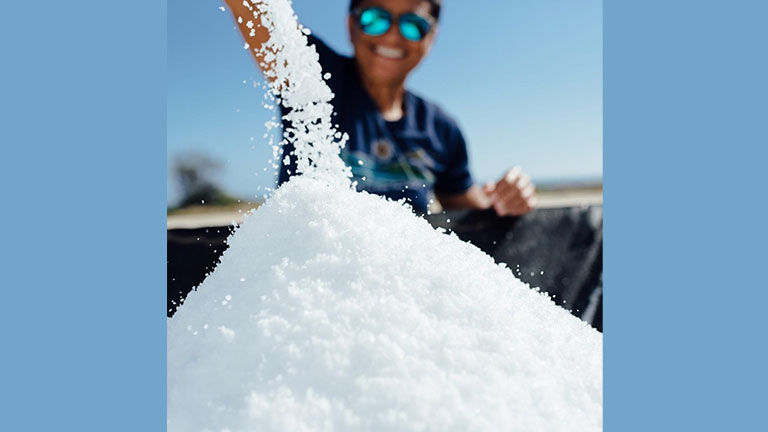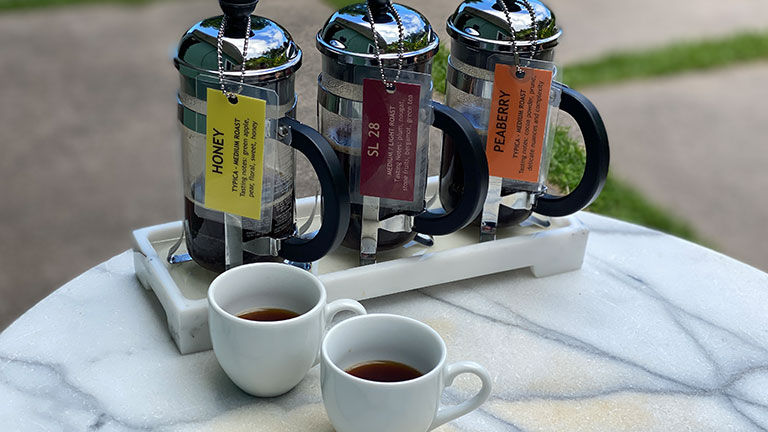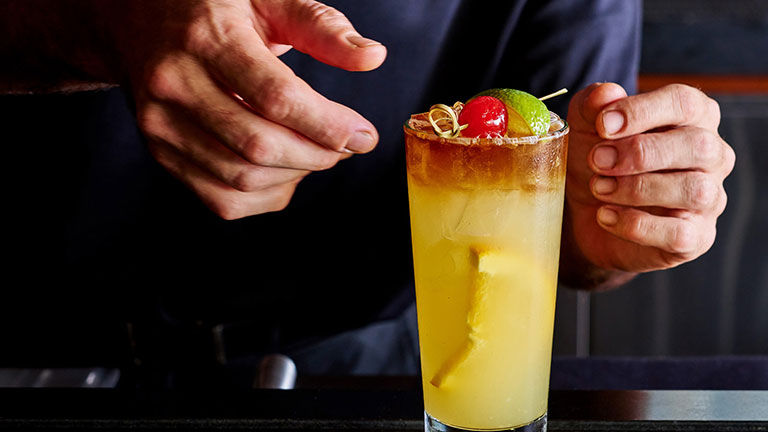“Hyperlocal” is a buzzword that gets thrown around a lot — even when it doesn’t really apply. However, in the case of these culinary experiences on the Big Island of Hawaii, the term couldn't be more accurate.
From coffee roasting to seasonal cocktail-making, here are four must-try hyperlocal tours and classes for clients visiting Hawaii Island.
Kona Sea Salt’s Farm Tour
Kona Sea Salt claims to be the only sea salt in the world made from pure, 900-year-old deep ocean water drawn from 2,200 feet below the surface. Being semi-scientifically minded (and fully salt-curious), my son Josh and I recently visited Kona Sea Salt’s salt farm to find out more.
“A lot of sea salt is made from surface water, which we now know contains microplastics and contaminants,” explained our guide, Candy, during the 45-minute Kona Salt Farm Tour. “But we're bringing up pre-industrial seawater from polar icecap melt, so it's coming from a super-clean source.”
Kona Sea Salt’s farm then uses evaporation tunnels to solar-dry the salt; each is filled with 1,000 gallons of deep seawater, which yields about 300 pounds of salt every four to six weeks. Candy noted that everything is done by hand, from harvesting and sorting to labeling — and almost entirely by women.
 Kona Sea Salt is made from 900-year-old deep ocean water.
Kona Sea Salt is made from 900-year-old deep ocean water.
Credit: 2022 Kona Sea SaltAfter our tour, Josh and I sampled pure and flavored salts on pineapple, cucumber and tomatoes to see how the seasonings can enhance food. (The best part? Kona Sea Salt has 30% less sodium than other salts.)
The Farm Tour is available daily at 10 a.m. and noon; sunset tours are offered on select dates.
Hala Tree's Coffee Roasting Tour in Kona
Josh and I arrived for out tour at organic Kona coffee farm Hala Tree expecting to sip coffee while someone else did the work. Instead, my son and I not only learned about the process that turns pale-green, estate-grown coffee beans into a chocolate-brown dark roast — we also did it ourselves.
Before we began the Coffee Roasting Tour in Kona, our guide, Cat, explained that we needed to watch for three phases while roasting: the “dry end,” when chlorophyll is cooked out; the Maillard phase, when sugars and amino acids break down; and the development phase, when flavor notes are developed. But she also pointed out that time and temperature for each phase vary with every roast.
“Roasting is a fluid process,” Cat told us. “The main thing you want is for your coffee to taste good at the end.”
She then walked us through the steps, from “charging” the beans (dropping them into the roaster) to “dropping” the beans (removing them when they are done). In between, she had us repeatedly check for the phases to ensure we achieved the perfect dark roast.
 The roasting class concludes with a tasting flight.
The roasting class concludes with a tasting flight.
Credit: 2022 Samantha Davis-FriedmanCoffee-loving clients will be happy to know that after roasting, the class includes a three-coffee tasting. We chose medium-roast Honey, SL 28 (a medium-to-light roast with notes of plum, bergamot and green tea) and Peaberry (rare single coffee beans). Our favorite was Peaberry, which we purchased to brew at home.
The one-hour roasting class is offered Mondays and Tuesdays for up to six people.
The Hawaiian Vanilla Co.'s Fresh Vanilla Luncheon & Guided Vineyard Tour
Josh and I figured the best way to learn about cultivating vanilla — a type of orchid that’s commercially grown in Hawaii — was to go to the source (and to make sure the source was a place we could have samples).
So, we opted for the Fresh Vanilla Luncheon & Guided Vineyard Tour at The Hawaiian Vanilla Co. In 1998, the Reddekopp family moved from the hustle and bustle of Honolulu to the Hamakua Coast of Hawaii Island, where they became the first commercial vanilla growers in the U.S.
Our education began with a vanilla-inspired meal that included vanilla butter-basted shrimp with vanilla pineapple chutney; vanilla bourbon-marinated chicken breast on a vanilla sweet bread bun; and salad with vanilla-raspberry balsamic dressing and vanilla honey-peppered pecans — all prepared by Elliot Reddekopp, who also provided the “Vanilla 101” presentation and farm tour.
 Clients will learn about growing, hand-pollinating and curing vanilla at Hawaiian Vanilla Co.
Clients will learn about growing, hand-pollinating and curing vanilla at Hawaiian Vanilla Co.
Credit: 2022 Hawaiian Vanilla Co.“My dad wanted to grow something but didn’t know what,” Elliot said. “My grandma, a retired geography professor, knew the U.S. consumed the most vanilla in the world and produced the least, so she lobbied for vanilla.”
Elliot told us that his father, Jim, traveled to Mexico to learn from growers, but quickly discovered their methods didn't work in Hawaii — so he developed his own system for growing, hand-pollinating and curing vanilla.
“When vanilla flowers bloom, they’re only open for four hours, so you’ve got to be there,” Elliot said.
Elliot explained that originally, his father pollinated every flower, but now, the family only pollinates the first two to three clusters (there are seven to 10 flowers per cluster), so they get about 30 beans per plant. Jim developed a labor-intensive nine-month bean-curing method that involves blanching and bundling, then sweating and wiping for mold daily.
The well-deserved result is Grade A Hawaiian vanilla beans, which we happily sampled in the form of vanilla bean ice cream after the tour.
The two-hour lunch and tour is offered weekdays at 12:30 p.m. Clients can also opt for a one-hour farm tour offered on weekdays and select Saturdays at 1 p.m., which includes a vanilla presentation, farm tour and dessert.
Farm-Fresh Cocktails at Four Seasons Resort Hualalai’s Hualalai Grille
At Four Season Resort Hualalai’s steakhouse, Hualalai Grille, cocktails highlight ingredients from the resort’s culinary garden. Referred to by mixologist Jeff Barnett as “Garden to Glass,” the idea behind the cocktail program is for the property’s chefs, mixologists and landscapers to produce and use vegetables, fruits and herbs that are native to or commonly used in Hawaii.
 “Jeff’s Fresh-Press ‘Tai” is a guest favorite at Hualalai Grille.
“Jeff’s Fresh-Press ‘Tai” is a guest favorite at Hualalai Grille.
Credit: 2022 Four Seasons Resort HualalaiBarnett told me the garden allows him to create seasonal cocktails with fresh ingredients and house-made, all-natural syrups.
“Garden to Glass is something I started here and guests love it,” he said. “I go to the garden and go crazy — cucumbers, Thai basil, kumquat, calamansi, apple bananas — there’s no limit to what I can do.”
A guest favorite is “Jeff’s Fresh Pressed ’Tai,” a twist on a traditional Mai Tai that's made with freshly muddled pineapple, orange and lime; orgeat syrup; orange curacao; agave nectar; and Kuleana Huihui rum.